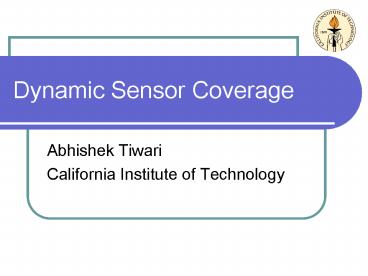Dynamic Sensor Coverage - PowerPoint PPT Presentation
1 / 28
Title:
Dynamic Sensor Coverage
Description:
We say that the dynamic sensor coverage problem has been successfully solved if ... Theoretical framework for the Dynamic Coverage problem. ... – PowerPoint PPT presentation
Number of Views:53
Avg rating:3.0/5.0
Title: Dynamic Sensor Coverage
1
Dynamic Sensor Coverage
- Abhishek Tiwari
- California Institute of Technology
2
Collaborators
- Dr. Myungsoo Jun, GERC, UFL
- Dr. David E. Jeffcoat, AFRL-MN Eglin Air Force
Base. - Dr. Richard M. Murray, Caltech
- Dr. Babak Hassibi, Caltech
3
Outline
- Introduction, motivation and applications of the
problem. - Related previous work.
- Problem description.
- Kalman filtering review.
- Markov chains review.
- Some results for the single sensor case.
- New results under coupled environment.
- Future work and discussion.
4
Introduction
- Given An uncertain region in space.
- Task Maintain an appreciable estimate of
uncertain parameters at each point in the region.
- Apparatus/tools A FEW limited range
mobile sensors.
5
Motivation/Applications
Weather monitoring Parameters
Temperature, Pressure, Humidity, Wind
speed/direction.
Surveillance Parameters Intruders
6
Motivation/Applications
Situational Awareness Parameters friends, enemies
Roboflag Parameters Location of opponent robots
7
Past Work
- Static coverage techniques based on Voronoi
partitions. (Cortes et. al.) . - ITAC 2004
- Dynamic sensor coverage experiments. (Batalin,
Sukhatme). SPIE 02 - Kalman filtering with intermittent observations.
(Sinupoli et. al.) CDC03 - Markov chains for search and surveillance.
(Jeffcoat, Stone).
8
Problem Description
N discrete time systems.
- Assumptions --------------
- The systems are decoupled.
- The noise processes are independent at different
locations.
9
Problem Description
Limited range A sensor has access to the
measurement of system i, iff it is currently
at system i. Algorithm Sensors send their
measurements to the base station which employs
a kalman filter to estimate the states of all N
systems.
Kalman Filter
10
Kalman filter review
- Sensor at system i ? Execute both time and
measurement updates. - No sensor at system i ? Execute only time update
.
11
Problem Description
Sensor motion modeled by a Discrete Time
Discrete State Markov chain.
We need some additional properties
12
Markov chain review
Defn. A DTDS Markov chain is called irreducible
if, starting from any one of the states, it is
possible to get to any other state (not
necessarily in one jump) with a non-zero
probability.
Defn. A state i of a Markov chain has period
d if, given that , we can only have
when n is a multiple of d. We call
i periodic if it has some period gt 1. If the
markov chain is irreducible, then either all
states are periodic or none are.
13
Markov chain review
- Defn Suppose is a DTDS Markov chain with
finite number of states, - is ergodic if
- is irreducible
- is not perodic.
Ergodicity Theorem
14
Problem Description
The idea is to write down the kalman filter
equations and then let .
15
Modified Riccati Recursion
To maintain an appreciable estimate of the states
of all N systems we want that
remains bounded for all i.
16
Modified Riccati Recursion
17
Problem Statement
Defn. We say that the dynamic sensor coverage
problem has been successfully solved if for any
initial probability distribution of the sensors
the N limits
are finite for any set if initial conditions
If there exists an
such that is unbounded
for some ,then the sensors have
failed to solve the dynamic coverage problem.
18
Single sensor case
N discrete time systems.
- Assumptions --------------
- The systems are decoupled.
- The noise processes are independent at different
locations.
19
Failure result
Failure Theorem
20
Results for a single sensor
Success result Quasi-convex feasibility
condition. No closed form condition.
http//www.cds.caltech.edu/atiwari/
21
Coupled Environment
Assumption does not hold anymore
1
2
22
Coupled Environment
Unstable
Unstable
Stable
23
Coupled Environment
24
Coupled Environment
25
Multiple Sensors
Sensor 1
Measure of cooperation
Sensor 2
26
Conclusions
- Whats new? Theoretical framework for the
Dynamic Coverage problem. - Insightful Results are intuitive and provide
deeper insight. - Backward compatibility A lot of already existing
tools in Kalman filter and Markov chain
literature can be used. - Other areas Coupled Environment case can be
used to get meaningful results for packet based
networks. - Scalability The approach can be extended to
multiple sensors and systems with ease.
27
Future Work
- Stability region in the coupled environment case.
- Synthesis of the transition probability matrix.
- Multiple sensor case.
- Convergence to static coverage results as the
number of sensors increases. - Experiments. (Multi Vehicle Wireless Testbed).
- Networked control systems.
28
Thank you ?
- Questions ?































